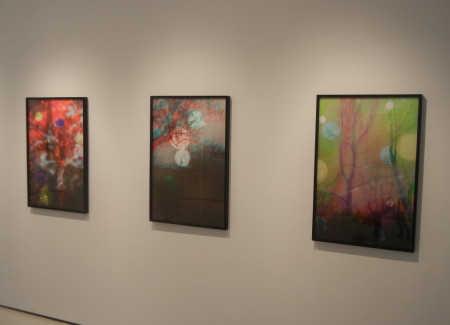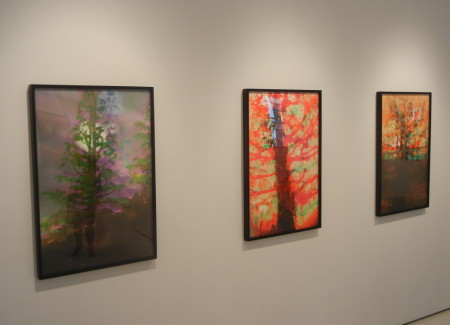JTF (just the facts): A total of 77 color photographs, framed in black and unmatted, and hung against white walls in the main gallery space. All of the works are archival inkjet prints, made in 2013 and 2014. 42 of the works are sized 4×6 (or reverse) and have money, lottery tickets, or other photographs hidden inside the frame; there is also one set of 20 prints, also each sized 6×4. The other 11 prints are sized 35×24 (or reverse). All of the works are unique. The show also includes two artist books in a vitrine, Unique Photographs and Changing of the Guard, in editions of 200, both from 2013. (Installation shots below.)
Comments/Context: Last summer, I was poking around in the 2nd floor bookshop at MoMA, and I pulled down Thomas Demand’s Executive for a closer look. As I flipped through the pages, something fluttered to the floor; I thought it was a response card from the publisher, but on closer examination, it turned out to be one of Fred Cray’s unique photographs. In contrast to the perfect sterility of the Demand images, it was a picture of a guy with no shirt in an overstuffed messy office, perhaps taken from a TV, with two holes punched in it, and a stamp and number on the back (see last install shot). Here was another artist interrupting Demand (in the confines of a hallowed museum no less), subtly commenting on the work in the book with a photograph of his own, bringing guerrilla intervention and artistic serendipity back to photography. I thought it was incredibly smart.
As it turns out, Fred Cray has been leaving/hiding his photographs all over the place for years now, some 10000 unique prints deposited all over the globe, so clearly, I’m not the only one to have experienced this unexpected moment of intimate visual conversation. This show brings together a broad sampler of Cray’s unique photographs, both in the handy small size (perfect for surreptitious delivery) and in a larger size that is more visually striking, as well as a pair of artist books that document the ongoing project.
In an age when we are drowning in seemingly endless photographic reproduction, Cray is using digital technology to make unique objects; it’s almost a contrarian position to take in such an environment. And the “how” of his work seems almost intentionally opaque – are the works multiple exposures, or layers of sandwiched images, or copies and tweaks? But as I wandered amid these works for a while, the process fell away – it doesn’t much matter how he has achieved his original effects. The experience is altogether hand crafted and painterly, with architectural silhouettes and towering trees tinted with washes of color, dotted with what might have been sun glare but could just as easily be filtered circular abstractions, coming together in a kind of hallucinogenic fog, where colors and forms dissolve into an ethereal set of echoes. They’re like a scene caught in your peripheral vision, a hazy transitory glance or a blurred memory.
Many of the smaller prints have been punched with physical holes – large, small, snowflake shaped, breaking up the image and reminding us of their physical presence. They also allow us to see “through” the print (almost an inside photography joke), in this case, to the hidden snippets of metallic lottery tickets or etched green dollar bills framed behind the artworks and another layer of surprise and opportunity for the lucky buyer. Another set of works documents the bearded face of a guard at the Met, overlaid with a dizzying variety of visual interventions and puns. There is an intellectual rigor here being applied to photography, a thoughtful testing of limits and recombinations.
While it may sound simplistic, what I like best about these unique works by Fred Cray is that they don’t look like anything we’ve seen before. His trees are at once bold and transitory, physical and impermanent, his buildings combining angularity and evanescence, hard edges and fluttering diffusion. His pictures are a reminder that digital doesn’t have to mean machined to perfection and drained of meaning. And by placing his works out in the bustle of life, he’s telling us that there is still a place for daring experimentation sized for individual discovery in this art world. These works succeed both as innovative photographs and as clever acts of intrusion, infringement, and commentary, and I for one, am now keeping my eyes peeled for more unpredictable Fred Cray ideas hiding in plain sight, waiting to be found.
Collector’s POV: The works in this show are priced as follows. The larger 35×24 prints are $5500 each, while the smaller 6×4 individual prints are available for $150 each; the set of 20 small prints is priced at $3000. The artist books are $100 each. Cray’s work has very little secondary market history, so gallery retail remains the best option for those collectors interested in following up.













This is probably not going to go down to well but the idea of ‘intellectual rigor’ even belonging in the same building as an artist – no, I don’t think so, doesn’t happen (well OK, maybe Grayson Perry is an exception).
Obfuscation, met with poorly considered – invariably overly generous – interpretation, and backed by supportive critical texts, can certainly create the illusion of ‘intellectual rigor’ – where it does not exist. And what smarts are in play are certainly nowhere near the level we would demand in other fields of rational thought (science, philosophy, politics, law etc.).
But I’d argue why do we require artists to be intellectual and rigorous, or even particularly intelligent? There are other kinds of rigor required of artists, the kinds that they deliver on and which matter just as much.
Well said, Pete.
I found a Fred Cray photograph in a book I bought in a Dallas, Texas used bookstore about a year ago. On a whim, I looked him up not expecting anything like this. I’m obsessed now and thrilled to be a part of it all.